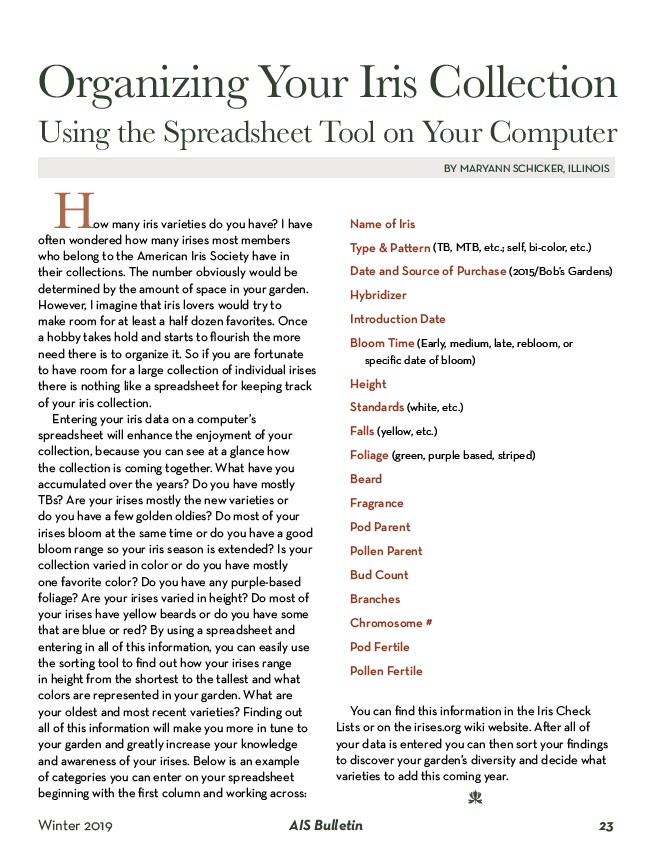
Organizing Your Iris Collection
Using the Spreadsheet Tool on Your Computer
BY MARYANN SCHICKER, ILLINOIS
How many iris varieties do you have? I have
often wondered how many irises most members
who belong to the American Iris Society have in
their collections. The number obviously would be
determined by the amount of space in your garden.
However, I imagine that iris lovers would try to
make room for at least a half dozen favorites. Once
a hobby takes hold and starts to flourish the more
need there is to organize it. So if you are fortunate
to have room for a large collection of individual irises
there is nothing like a spreadsheet for keeping track
of your iris collection.
Entering your iris data on a computer’s
spreadsheet will enhance the enjoyment of your
collection, because you can see at a glance how
the collection is coming together. What have you
accumulated over the years? Do you have mostly
TBs? Are your irises mostly the new varieties or
do you have a few golden oldies? Do most of your
irises bloom at the same time or do you have a good
bloom range so your iris season is extended? Is your
collection varied in color or do you have mostly
one favorite color? Do you have any purple-based
foliage? Are your irises varied in height? Do most of
your irises have yellow beards or do you have some
that are blue or red? By using a spreadsheet and
entering in all of this information, you can easily use
the sorting tool to find out how your irises range
in height from the shortest to the tallest and what
colors are represented in your garden. What are
your oldest and most recent varieties? Finding out
all of this information will make you more in tune to
your garden and greatly increase your knowledge
and awareness of your irises. Below is an example
of categories you can enter on your spreadsheet
beginning with the first column and working across:
Name of Iris
Type & Pattern (TB, MTB, etc.; self, bi-color, etc.)
Date and Source of Purchase (2015/Bob’s Gardens)
Hybridizer
Introduction Date
Bloom Time (Early, medium, late, rebloom, or
specific date of bloom)
Height
Standards (white, etc.)
Falls (yellow, etc.)
Foliage (green, purple based, striped)
Beard
Fragrance
Pod Parent
Pollen Parent
Bud Count
Branches
Chromosome #
Pod Fertile
Pollen Fertile
You can find this information in the Iris Check
Lists or on the irises.org wiki website. After all of
your data is entered you can then sort your findings
to discover your garden’s diversity and decide what
varieties to add this coming year.
d
Winter 2019 AIS Bulletin 23